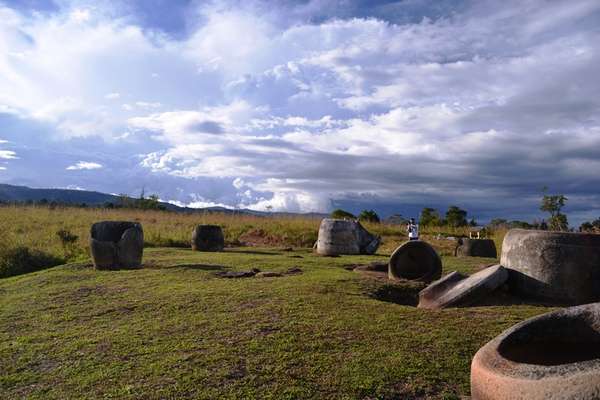I. Stone Which more or less resemble the natives present paddy mortras of wood, with one or more hollows to place the paddy in. These stones gave a more or less flat upper side with one more round holes or hollows. The are called by the natives Stone nondju or nonju dji.
- Rather small stones (about 50 cm in diameter) with only sightly polished upper side adn a relatively small hollow, 10 X 4 cm. (kulawi)
- Stone as a rule somewhat larger (60 to 100 cm )with a relatively well polished upper side qith a hole or hollow about 15 to 25 cm in diameter and 12 to 16 com deep. (Palu Valley, Palolo,Lindu, Kulawi, Potonoa, Mopahi, Bada, Behoa, secopada).
- Like the foregoing type execot that the stones are definitely larger and to contain two (Kuwali) or more hollows (Lindu).
- Like type b) except that around the mouth of the hollow runs a circular groove, separated ftom the hollow by an upright of wall.( Kantewu).
- Like type b), except for a low wall round the mouth of hollow.(Buleli in Bada)
- Appproximately like b) Execept that the outer edge if the flat surface has low upright wall of ridge. These stones are either rectangular (kulawi) or round (Tawaelia)
II. Deep, almost goblet or cup - like,hollowed out stones. the hollowe is about 17 cm in diameter abd about 15 cm deep (Behoa and Bada)
III. Stone blocks with a number of more less rounded of irregularly formed hollows.
a. Rather large and not especially worked stones with rather few (kantewu), or very many small, hollows on the upper side (kutawi)
b. Rather small stones more or less flat with a diameter of 35 to 50 cm and with polshed edges abd a number of hollows in both the upper and under side (peana, Mopahi). These stones are called watu Morobe
IV. Stone with a More or less oblong shallow hollows (mopahi).These Are Also called Watu nondju or nonju dji.

V. Relatively large, slightly polished stone block with a very large hollow of shape of an egg cup (Mopahi)
VI. Flat stones with a shallow circual groove on the upper side (Kantewu,Peana). The natives call them watukulili.
VII. Larger more of less Cylinricial, stone vats called karamba
a. Plain wihout decaoration (Bada, Behoa)
b. Similar to the above in form but also equipped with a number if cirular raused bands (Behoa).
c. Similar to the above in from but wiht the addition of decoration in relif (behoa).
d. Some stonne vats, belonging also to the kalamba (behoa). Perhaps one may include with the kalamba the stone at Mopahi sunk in the earth in wich a plam tree has taken root.
IX. Large, flat more or less round, stones called tutuna.
a. Round, flat stones without any other deciration than possibly a raised section in the center (Bada,Behoa).
b. Round, flat stones decorated wih inised patterns (Bada,Behoa).
c. Round stones equipped with decorations in very high relief.
d. Oval stones with low relief if ubcusuib (Jaentu Valley).
X. Monolithic sculptures (Buleli, Bada, Behoa).
RAVEN in his paper of 1926 says he saw at Buleli, near Doda, the stone statue called Tadu Laku. (it Was the statue called Watu Miangka KILIAAN, and Tadulako by KRUYT).
 | |
| Stones vat ("watoe loemoe ") Napu |
he writes as follows : "Tadu Laku, it is said was an ancient locak war leader and the natives believe the inage ti be the chieftain himself and not merely a representation of him. The satatue ................ stands about seven feet high, is about thirty inches wide, and is made frin a single block of granite. The accompanying phetorgraphs, Showing both front and side views, make detaliled description unneccessary but it may be well to call attention to some of the characters which are not so clear, owing to the low relief in which they wewe execute :
- The ear are represnted by bumps high up on the sides of the head, their lower borders being about the level if the eyebows.
- The sholders arms and hand are in low relief, the fingers pressed to the lower abdominal region.
- The male generative organ in higher relief is upgright and to be seen clearly in th profile.
- The limit of the forehead is marked, evidance that headgear of some sort only weathered head was visible, A warining tree had wound some of is roots round it. A similar inage is at Bada-Mpu`u KRUYT says. The image in best condition, he saw at the village of bomba. According to KRUYT it represents a wmen, The natives called it Langkae Bulawa, Golden anklet.(bulawa = gold, langke = angklet)
XIII. Stones standing upright, so-called Menhirs
- Stones standing alone (Kantewu,Peana)
- Two menhirs besude each others (Massarow-Mangura)
- Several upright stones in tow rows (Saadang region)
- Stone Ranged in a circke (Saadang region) to This group belong aoorenly the five upright stones on the northern shore of lake Poso. Perhaps one should also place here the four irregular stone blocks tound the stone chest in Mopahi.
 |
| Tadulako |
No comments:
Post a Comment